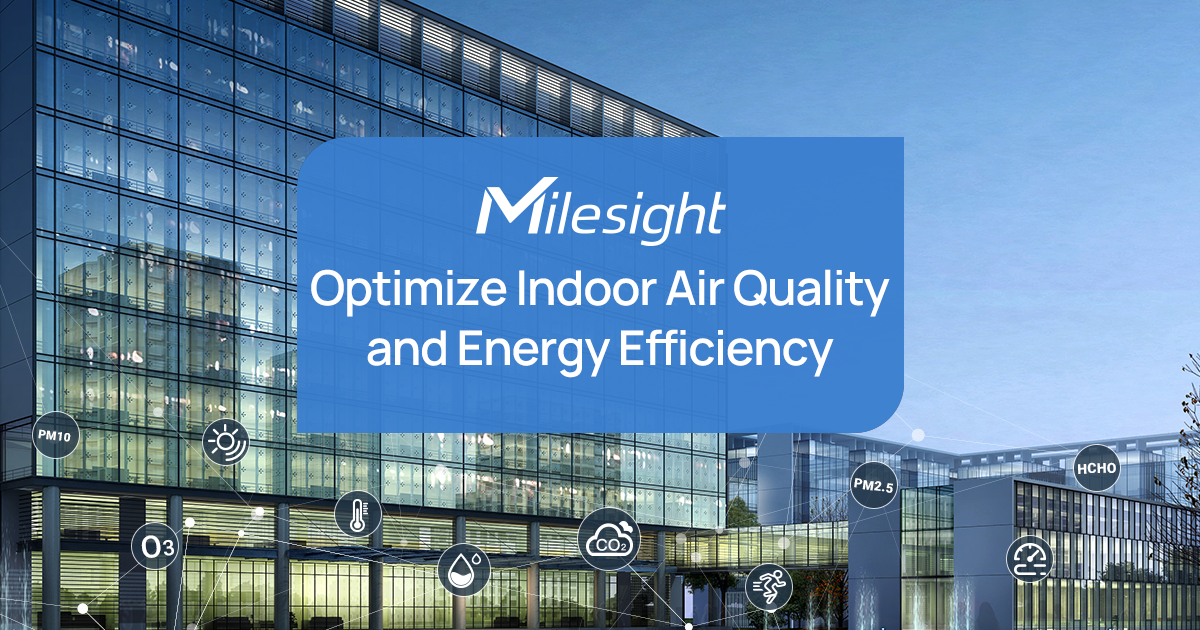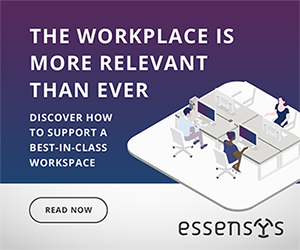Optimizing Indoor Air Quality and Energy Efficiency in Buildings Post COVID-19

The year 2020 was an unprecedented challenging year in the human history when the COVID-19 pandemic spread all over the world, bringing massive negative impacts on individuals and businesses. One and a half years later, though many countries are declaring the crisis chapter over and are gradually adapt to the new normal - “living with the virus” - millions of lives are still at stake as the schools reopen and employees resume to work. There seems to be many emerging challenges needed to be addressed. In the so-called new normal, how do we protect ourselves and our people under post COVID-19?
Success Story 1
Milesight 47,000 IAQ Sensors Create a Healthier Learning Environment in Canadian Schools
The World Health Organization (WHO)  has acknowledged there is “emerging evidence” that COVID-19 could be spread through particles in the air. Other research indicates the coronavirus could remain in the air for more than eight minutes after talking. Normal speech could generate airborne droplets that can remain suspended for tens of minutes or longer and are eminently capable of transmitting disease in confined spaces. Under this circumstance, apart from routine measures like mask wearing and hand washing, indoor air quality (IAQ) improvement could be of great help in reducing aerosol transmission. In September 2021, the Ministère de l’Éducation du Québec announced the deployment and installation of air quality sensors in more than 47,000 classrooms across the province. Real-time readings of three comfort parameters (CO2 concentration, temperature and the level of relative humidity) allow them to make changes more gradually and quickly in the affected rooms by, for example, adjusting the inflow of outdoor air or completely air out a classroom during a break. Thus, a safer and healthier environment is created for students and staff for more productive efforts.
has acknowledged there is “emerging evidence” that COVID-19 could be spread through particles in the air. Other research indicates the coronavirus could remain in the air for more than eight minutes after talking. Normal speech could generate airborne droplets that can remain suspended for tens of minutes or longer and are eminently capable of transmitting disease in confined spaces. Under this circumstance, apart from routine measures like mask wearing and hand washing, indoor air quality (IAQ) improvement could be of great help in reducing aerosol transmission. In September 2021, the Ministère de l’Éducation du Québec announced the deployment and installation of air quality sensors in more than 47,000 classrooms across the province. Real-time readings of three comfort parameters (CO2 concentration, temperature and the level of relative humidity) allow them to make changes more gradually and quickly in the affected rooms by, for example, adjusting the inflow of outdoor air or completely air out a classroom during a break. Thus, a safer and healthier environment is created for students and staff for more productive efforts.
Post COVID-19, there is no doubt that the whole-building ventilation is needed for improving IAQ. However, it turns out to be more energy consumption. Research reveals that some buildings are lacking enough ventilation, while others have high ventilation rates that are more than needed which will definitely waste energy. How to achieve a balance among them and get good results?
Success Story 2
Milesight 4,400 Sensors Help Optimize Energy Efficiency and Indoor Air Quality in Canadian Buildings
The answer is turning environment data  into actionable insights to guide the whole ventilation process. The vivid example is our Smart Building Solution. In Canadian commercial buildings, together with our partner, Peak Power, deployed 4,400 sensors to help optimize indoor air quality and energy efficiency. In this use case, the sensors are installed on each floor to monitor building data, including indoor ambience temperature, humidity, carbon dioxide concentration, people counting and many more, while AI-powered analytics integrate this information with additional data sources to forecast peaks in demand. A mobile app or desktop portal delivers data-driven recommendations for optimizing and reducing energy consumption at peak times. The Milesight LoRaWAN® gateway is installed approximately every 3-stories with PoE power input and has been tested to be working at least 2km away. The 4G module in the gateway provides an easy Internet connection for data transmission. The building energy optimization platform contains three key components, namely data collection, data analysis, and data visualization portals, which work together to provide building owners, operators, and managers with energy-saving advice.
into actionable insights to guide the whole ventilation process. The vivid example is our Smart Building Solution. In Canadian commercial buildings, together with our partner, Peak Power, deployed 4,400 sensors to help optimize indoor air quality and energy efficiency. In this use case, the sensors are installed on each floor to monitor building data, including indoor ambience temperature, humidity, carbon dioxide concentration, people counting and many more, while AI-powered analytics integrate this information with additional data sources to forecast peaks in demand. A mobile app or desktop portal delivers data-driven recommendations for optimizing and reducing energy consumption at peak times. The Milesight LoRaWAN® gateway is installed approximately every 3-stories with PoE power input and has been tested to be working at least 2km away. The 4G module in the gateway provides an easy Internet connection for data transmission. The building energy optimization platform contains three key components, namely data collection, data analysis, and data visualization portals, which work together to provide building owners, operators, and managers with energy-saving advice.
How Does It Work?
Once the gateway receives the data from the Milesight LoRaWAN® sensors, the embedded network server is going to forward data by MQTT to the platform via the cellular network. With Peak Power’s platform, operations managers can remotely monitor smart building conditions, equipment and occupancy, and get automatic alerts when the indoor temperature leaves the range of 21℃-26℃, humidity falls below 40%, or the environmental condition makes occupants more vulnerable to viral respiratory infections, or when CO2 levels exceed 800 ppm indicating that not enough fresh air for the number of people in the smart building. All these alerts will guide the HVAC system to work and create more comfortable, safer and healthier building environment.
Value to Commercial Buildings
- Provide Accurate Indoor Air Quality Insights: Provide accurate indoor environment data each day to help the whole operation in the building.
- Increase Energy Efficiency and Lower Power Consumption: Time-based and remote ON/OFF, according to the real-time building data, save standby power consumption.
- Allow Wider and More Solid Network Coverage: Based on LoRaWAN® technology, our devices offer wide and rock-solid single coverage. With just a few gateways, they can cover the entire building.
- Lower Maintenance and Labor Cost: LoRaWAN® technology extends our sensors’ battery life to 10+ years, reducing repetitive and maintenance work.
Although the pandemic has reminded us of human vulnerability, it is more like a demonstration of our resilience and adaptability. It is a time when technology takes center stage. Levering LoRaWAN® and AIoT technology, Milesight contributes to combating the pandemic by its Smart Building Solution. For the years to come, we ares going to roll out more connected and integrated products and solutions to cope with the new normal.
This Week’s Sponsor
Milesight IoT is a fast-growing and innovation-driven technology company with a focus on 5G, AI, IoT and LoRaWAN. With advanced IoT insights, the company is committed to driving next-level technology innovation and business efficiencies in an actionable and locally adapted way. For more information, please visit www.milesight-iot.com.
Read Next
 3/27/2025
3/27/2025
The Convergence of Edge Computing, Cloud, and AI in Building Automation and Smart Buildings In the built environment, we have seen the convergence of Operational Technology (OT) and Information Technology (IT), later expanding to include Workplace Technologies (WP).
 3/27/2025
3/27/2025
DC Power: A Holistic Approach to Energy Savings in Commercial Buildings In today's energy-conscious world, businesses constantly seek ways to reduce their carbon footprint and operational costs.
 3/13/2025
3/13/2025
How to Achieve Eco-Friendly Facility Management Commercial real estate operators and facility managers are focusing on sustainable practices to minimize environmental impact, create healthier workplaces, improve productivity and lower operational costs.
 1/23/2025
1/23/2025
When It Comes To Managing Properties’ Parking, Technology Is Key It’s easy for developers and real estate owners to think of parking as a necessary evil. They know they have to provide it (often, because it’s mandated by code), they understand that prospective tenants and buyers expect to be provided parking, but they haven’t figured out how to maximize its value.






.gif)





